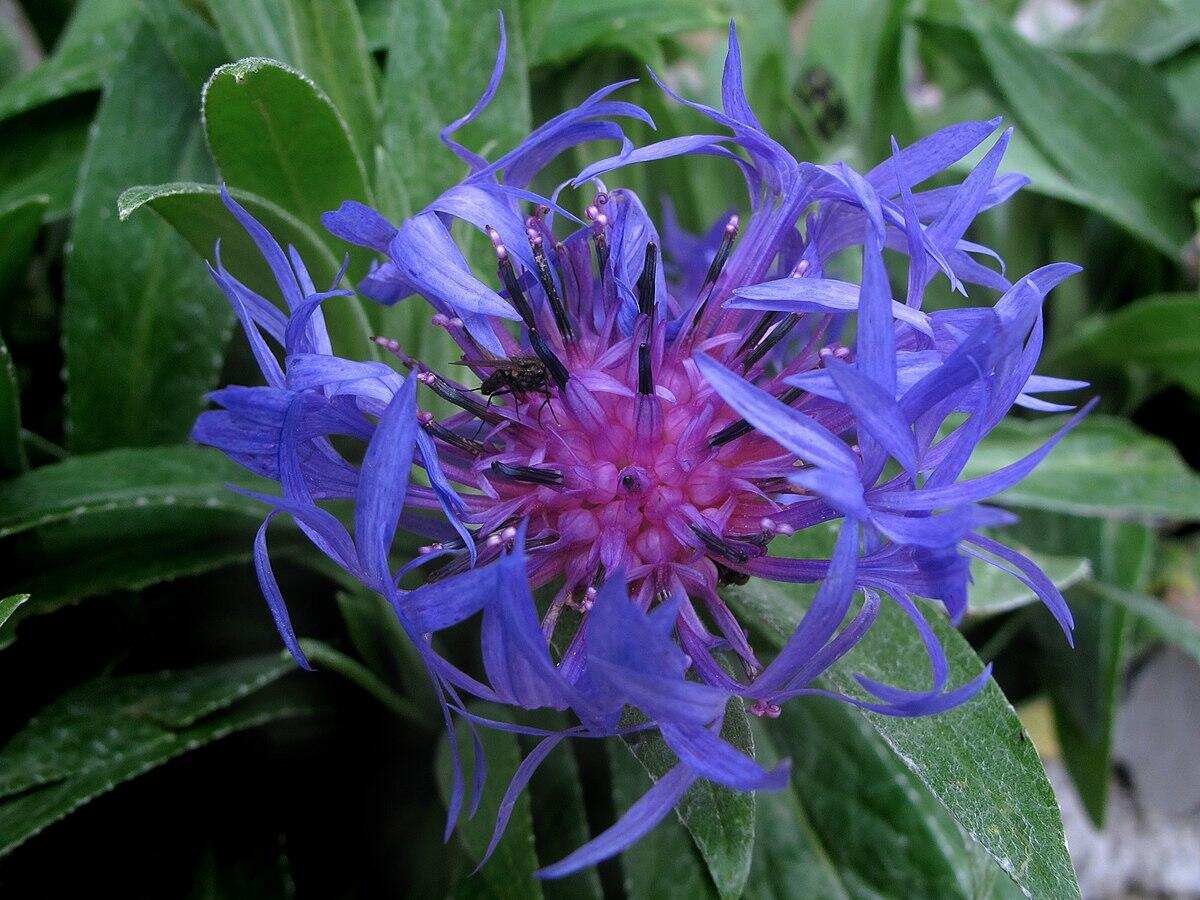Mountain Cornflower, also known as Mountain Bluet, Perennial Bachelor’s Button, or Perennial Cornflower, is a hardy flowering plant with the botanical name Centaurea montana. Belonging to the Asteraceae family, this perennial species (montana) is native to the mountainous meadows and woodlands of Europe.
Widely cultivated as a garden plant and cut flower, the Mountain Cornflower is valued not only for its ornamental appeal but also for its historical use in traditional medicine across Central Europe, despite being inedible. This plant plays an important role in supporting pollinators like bees, butterflies, and moths, making it a favorite for eco-conscious gardeners. However, it has also become invasive in certain regions, such as British Columbia, where its spread is carefully monitored.
| Common name | Mountain Cornflower, Mountain Bluet, Perennial Bachelor’s Button, Perennial Cornflower |
| Botanical name | Centaurea montana |
| Family | Asteraceae |
| Species | montana |
| Origin | Europe |
| Life cycle | Perennial |
| Plant type | Perennial |
| Hardiness zone | 3, 4, 5, 6, 7, 8 |
| Sunlight | Full Sun |
| Maintenance | Low |
| Soil condition | Clay |
| Soil ph | Acid |
| Drainage | Occasionally Dry |
| Growth rate | Fast |
| Harvest time | Fall |
| Flowering period | Fall |
| Height | 1 ft. – 2 ft. |
| Flower color | Blue |
| Leaf color | Gray, Silver |
| Fruit color | Cream, Tan |
| Stem color | Gray, Silver |
| Fruit type | Achene |
| Flower benefit | Good Cut |
| Garden style | Cottage Garden |
| Uses | Meadow |
I. Appearance and Characteristics
Centaurea montana, the perennial cornflower, mountain cornflower, bachelor’s button, montane knapweed or mountain bluet, is a species of flowering plant in the family Asteraceae, endemic to Europe. It is widespread and common in the more southerly mountain ranges of Europe, but is rarer in the north. It escapes from gardens readily, and has thereby become established in the British Isles, Scandinavia and North America.
This plant has become an invasive species in British Columbia, Canada. Centaurea montana grows in meadows and open woodland in the upper montane and sub-alpine zones, in basic areas. It grows to 30–70 centimetres (12–28 in) tall, and flowers mainly from May to August.

Centaurea montana may be distinguished from other Centaurea species in the region by its usually entire leaves, and the blue-purple colour of the outermost ray florets. It may be distinguished from the cornflower, Centaurea cyanus, by having a single (rarely up to three) flower heads, and by its being perennial, whereas the cornflower has many flower heads and is annual. The closely related C. triumfettii has more narrowly winged stems, narrower leaves and grows in rockier areas.
Centaurea montana grows in gardens where it grows best in sunny positions. It tolerates some light shade. Since the plant is evergreen it can use the light in winter and early spring when deciduous trees and shrubs have no leaves. It tolerates deciduous shade better than evergreen shade and prepares to flower while deciduous plants are bare. Therefore, it can flower reasonably well in light deciduous shade.
If the plant is dug up, a new plant can eventually regenerate from small pieces of root left in the soil. Centaurea montana grows well in soils varying from light sand to heavy clay. The plant also grows well in acid, neutral or very alkaline soils. It tolerates drought but cannot tolerate waterlogged conditions. The Royal Horticultural Society considers it a good plant to attract pollinators, and it is widely available from commercial suppliers.
This plant is inedible; however, it is considered to be a medicinal plant in Central Europe.
II. How to Grow and Care
Sunlight

Plant your mountain cornflower in a spot that receives six to eight hours of full sun each day for optimal flowering. This plant can tolerate light shade, but locations that have too much shade can cause a reduction in blooms and make the plant grow spindly and floppy.
Temperature and Humidity
Mountain cornflower, as its name suggests, is native to the high-altitude meadows and woodland areas of central and southern Europe. That said, it grows well in all climate variations within its hardiness range but is an especially vigorous grower in northern climates. This flower prefers temperatures ranging from 59 F to 78 F and can even survive a light frost. Mountain cornflower likes things dry and does not grow well in a hot and humid environment.
Watering
The Mountain bluet is considered to have average watering needs compared to other similar species. It prefers consistently moist soil, which should not be allowed to dry out completely in between waterings. When the top layer of soil is dry, it is time to water the plant. Overwatering should be avoided, as this species can experience root rot.
Soil
Mountain cornflower needs sandy, well-drained soil to thrive, and it can tolerate dry, nutritionally poor soil quite well. This plant does not thrive in especially rich soils. Mountain cornflower isn’t that picky about soil pH either and can tolerate a range of levels, from 6.1 to 7.8.

Fertilizing
This easy-to-care-for plant dislikes rich soil. It needs virtually no feeding—not even an annual soil amendment with organic material. A single spring feeding is occasionally useful for plants growing in very poor soil conditions, but even then, fertilization is not necessary.
Pruning
Proper pruning influences the length of mountain cornflower’s bloom time, as well as its spread. To encourage a bushier spread, pinch back the ends of new growth early in the spring. Then, if desired, pinch off one-third of the plant’s buds to make the blooms larger. Once the first bloom period is over, snip off spent flowers to the first set of leaves to encourage another bloom. Annually, pull up volunteers to control spreading and divide the plant in the spring every two years.
Propagation
Dividing mountain cornflower clumps helps maintain the plant’s vigor and control its spread. Divisions can be planted elsewhere in your garden, gifted to friends, or transplanted into pots.
Here’s how to propagate mountain cornflower through division:
- Gather gloves, a spade shovel, a garden trowel, and garden shears.
- In the spring after the first growth appears, dig up your cornflower clump and place it on its side on the ground.
- Carefully pull apart sections that contain both growth and root using your trowel.
- Dig new holes for the individual plants and snip away any dead growth.
- Plant each new plant in a hole, backfilling to cover the roots. Relocate the mother plant to its existing hole and backfill in the same manner.
- Water all the plants thoroughly and keep the soil moist until the plants mature.
How to Grow from Seed
Mountain cornflowers will readily self-seed in your garden, but you can seed a garden bed yourself. Seeds can be purchased from a garden center or collected from last year’s flowers. Sow the seeds indoors eight weeks before your average last frost date by broadcasting them over a seed tray filled with seed-starting mix. Make sure to fully cover your seeds with soil, as they need complete darkness to sprout. Water the tray and keep the soil moist until seedlings appear in three to four weeks. Pull weak seedlings, allowing the others to grow, and transplant the hardy ones outside when the soil temperature reaches 60 F.
Potting and Repotting

Mountain cornflower makes a statement when grown in pots and containers. Select a clay or terracotta pot with several drain holes. Fill the pot with well-drained potting soil containing vermiculite or soilless medium. Mix in other annuals or perennials that prefer the same conditions. Once planted, water thoroughly and allow the pot to drain completely. Place your cornflower in a sunny spot to encourage blooms and make sure not to overwater it.
Overwintering
Mountain cornflower has adapted well to high-altitude and northern climates, eliminating the need to protect it during the winter. All that is needed to winterize this plant is a good cutback to the ground in late fall. Come spring, new growth will emerge from the cultivated mound.
How to Get to Bloom
Cornflowers bloom best when planted in full sun and deadheaded regularly. Removing old blooms will stimulate the plant to make new ones, and pruning encourages bigger blooms. If you have a particularly finicky patch that doesn’t seem to bloom, try adding an organic fertilizer high in phosphate. While cornflower usually prefers no fertilization, this little boost may help a sluggish patch bloom.
Pests and Diseases
Common Pests & Plant Diseases
There are few serious disease issues with mountain cornflower. Non-fatal fungal rust or mildew infections sometimes occur. To avoid these issues, make sure to give your cornflower clumps enough distance between plants and prune them around the center to aid in air circulation.
Aphids can move into a patch of mountain cornflower but can be easily controlled by reducing their population with several blasts from the garden hose. You can also use a soap and water spray to eliminate any lingerers. A stalk borer infection, while rare, can cause plant fatality, and your only indication may be a wilting plant that doesn’t recover. While this condition is untreatable, you can prevent it by regularly weeding your garden and pruning last year’s dead growth.
Common Problems
Mountain cornflower can become invasive if not kept in check. Natively, it grows rampant in nutrient-poor soil throughout corn and grain fields in Europe and is considered a weed. In naturalized areas, this plant can take over in just a few seasons, making it necessary to pluck volunteers and divide root clumps on a bi-annual basis to avoid mass proliferation.
III. Uses and Benefits

The short stature of perennial cornflower makes this early-summer flowering plant an attractive option at the front of perennial garden borders. It is also valuable in garden sites with low soil moisture and for planting in low-maintenance gardens.
IV. Types of Mountain Cornflower
Cultivars of mountain cornflower can be characterized by their colors, foliage, or growth pattern. Choose the type that best serves your gardening goals, keeping in mind that every variety is equally appealing.
Here are some gardeners’ favorites:
- ‘Amethyst Dream’ boasts lacy, deep purple petals with an even darker center. This type forms a low mound of grey-green leaves and makes a great border.
- ‘Amethyst in Snow’ is a unique spreading varietal that makes a good ground cover. It features fringe-like white petals surrounding a purple center.
- ‘Alba’ features snowflake-like white flower petals around a pink center. It grows up to 18 inches tall and spreads to 12 inches wide.
- ‘Black Sprite’ bears star-burst-shaped flowers of dark purple and blooms early in the summer. The cut flowers and spent blooms of this type don’t turn brown once dry.
- ‘Carnea’ is especially popular since it is the only pink cultivar and flowers all season long. This type grows to a mature height and spread of 15 inches.
Find Where to Buy the Best Mountain Cornflower (Centaurea montana)


















Leave a Reply